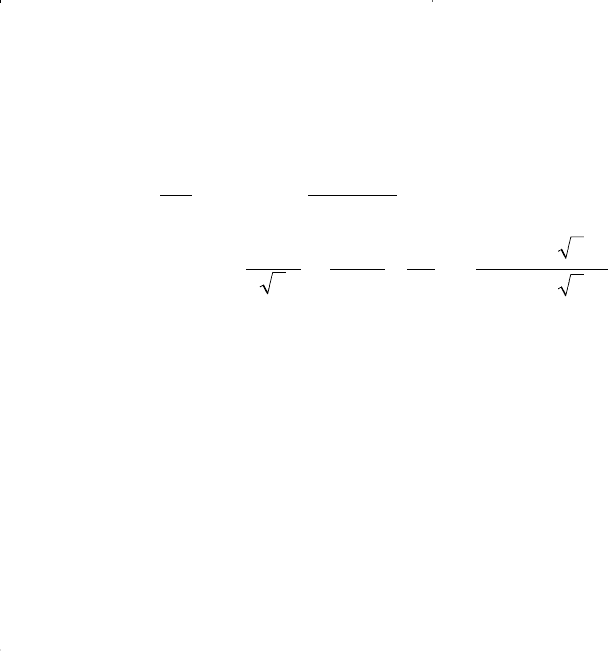Tarek Ahmed. Reservoir engineering handbook
Подождите немного. Документ загружается.


where
Equation 15-92 is also used to determine the fugacity coefficient of com-
ponent in the gas phase Φ
v
i
by using the composition of the gas phase y
i
in calculating A, B, Z
v
, and other composition-dependent terms, or:
where
Modifications of the SRK EOS
To improve the pure component vapor pressure predictions by the
SRK equation of state, Graboski and Daubert (1978) proposed a new
expression for calculating parameter m of Equation 15-70. The proposed
relationship originated from analyses of extensive experimental data for
pure hydrocarbons. The relationship has the following form:
Sim and Daubert (1980) pointed out that because the coefficients of Equation
15-95 were determined by analyzing vapor pressure data of low-molecular-
weight hydrocarbons it is unlikely that Equation 15-95 will suffice for high-
molecular-weight petroleum fractions. Realizing that the acentric factors for
the heavy petroleum fractions are calculated from an equation such as the
Edmister correlation or the Lee and Kessler (1975) correlation, the authors
proposed the following expressions for determining the parameter m:
m =+ −
(
)
0 48508 1 55171 0 15613
2
.. .ωω
15 - 95
ayyaak
m
ij iji j ij
ji
ααα
(
)
=−
(
)
[]
∑∑
1
Ψ
ijijijij
j
yaa k=−
(
)
[]
∑
αα 1
ln ln lnΦ
Ψ
i
v
i
v
m
v
i
m
i
m
v
bZ
b
ZB
A
Ba
b
b
B
Z
(
)
=
−
(
)
−−
(
)
−
(
)
−
+
1
2
1
α
axxaak
m
ij iji j ij
ji
ααα
(
)
=−
(
)
[]
(
)
∑∑
1
15 - 94
Ψ
ijijijij
j
xaa k=−
(
)
[]
(
)
∑
αα 1
15 - 93
ln ln lnΦ
Ψ
i
L
i
L
m
L
i
m
i
m
L
bZ
b
ZB
A
Ba
b
b
B
Z
(
)
(
)
(
)
(
)
(
)
=
−
−−− − +
1
2
1
α
15 - 92
1108 Reservoir Engineering Handbook
Reservoir Eng Hndbk Ch 15 2001-10-25 17:41 Page 1108

• If the acentric factor is determined by using the Edmister correlation, then:
• If the acentric factor is determined by using the Lee and Kessler cor-
rection, then:
Elliot and Daubert (1985) stated that the optimal binary interaction coef-
ficient k
ij
would minimize the error in the representation of all thermody-
namic properties of a mixture. Properties of particular interest in phase equi-
librium calculations include bubble-point pressure, dew-point pressure, and
equilibrium ratios. The authors proposed a set of relationships for determin-
ing interaction coefficients for asymmetric mixtures
2
that contain methane,
N
2
, CO
2
, and H
2
S. Referring to the principal component as i and the other
fraction as j, Elliot and Daubert proposed the following expressions:
• For N
2
systems:
• For CO
2
systems:
• For H
2
S systems:
• For methane systems with compounds of 10 carbons or more:
where
2
An asymmetric mixture is defined as one in which two of the components are consider-
ably different in their chemical behavior. Mixtures of methane with hydrocarbons of 10
or more carbon atoms can be considered asymmetric. Mixtures containing gases such as
nitrogen or hydrogen are asymmetric.
k
ij
ij
ij
∞
=
−−
(
)
(
)
εε
εε
2
2
15 -102
kkk
ij ij ij
=− −
(
)
(
)
∞∞
0 17985 2 6958 10 853
2
.. .
15 -101
kk
ij ij
=+
(
)
∞
0 07654 0 017921..
15 -100
kkk
ij ij ij
=− −
(
)
(
)
∞∞
0 08058 0 77215 1 8404
2
.. .
15 - 99
kk
ij ij
=+
(
)
∞
0 107089 2 9776..
15 - 98
m
ii
=+ −
(
)
0 315 1 60 0 166
2
.. .ωω
15 - 97
m
ii
=+ −
(
)
0 431 1 57 0 161
2
.. .ωω
15 - 96
Vapor–Liquid Phase Equilibria 1109
Reservoir Eng Hndbk Ch 15 2001-10-25 17:41 Page 1109

and
The two parameters a
i
and b
i
in Equation 15-103 were previously defined
by Equations 15-71 and 15-72.
The major drawback in the SRK EOS is that the critical compressibili-
ty factor takes on the unrealistic universal critical compressibility of
0.333 for all substances. Consequently, the molar volumes are typically
overestimated and, hence, densities are underestimated.
Peneloux et al. (1982) developed a procedure for improving the volu-
metric predictions of the SRK EOS by introducing a volume correction
parameter c
i
into the equation. This third parameter does not change the
vapor-liquid equilibrium conditions determined by the unmodified SRK
equation, i.e., the equilibrium ratio K
i
, but it modifies the liquid and gas
volumes. The proposed methodology, known as the volume translation
method, uses the following expressions:
where V
L
= uncorrected liquid molar volume, i.e., V
L
= Z
L
RT/p,
ft
3
/mol
V
v
= uncorrected gas molar volume V
v
= Z
v
RT/p, ft
3
/mol
V
L
corr
= corrected liquid molar volume, ft
3
/mol
V
v
corr
= corrected gas molar volume, ft
3
/mol
x
i
= mole fraction of component i in the liquid phase
y
i
= mole fraction of component i in the gas phase
The authors proposed six different schemes for calculating the correc-
tion factor c
i
for each component. For petroleum fluids and heavy hydro-
carbons, Peneloux and coworkers suggested that the best correlating
parameter for the correction factor c
i
is the Rackett compressibility factor
Z
RA
. The correction factor is then defined mathematically by the follow-
ing relationship:
cZTp
iRAcici
=−
(
)
(
)
4 43797878 0 29441..
15 -106
VV yc
corr
vv
ii
i
=−
(
)
(
)
∑
15 -105
VV xc
corr
LL
ii
i
=−
(
)
(
)
∑
15 -104
ε
i
i
i
a
b
=
(
)
0 480453.
15 -103
1110 Reservoir Engineering Handbook
Reservoir Eng Hndbk Ch 15 2001-10-25 17:41 Page 1110

where c
i
= correction factor for component i, ft
3
/lb-mol
T
ci
= critical temperature of component i, °R
p
ci
= critical pressure of component i, psia
The parameter Z
RA
is a unique constant for each compound. The val-
ues of Z
RA
are in general not much different from those of the critical
compressibility factors Z
c
. If their values are not available, Peneloux et
al. (1982) proposed the following correlation for calculating c
i
:
where ω
i
= acentric factor of component i.
Example 15-15
Rework Example 15-14 by incorporating the Peneloux volume correc-
tion approach in the solution. Key information from Example 15-14
includes:
• For gas: Z
v
= 0.9267, Ma = 20.89
• For liquid: Z
L
= 1.4121, Ma = 100.25
• T = 160°F, p = 4000 psi
Solution
Step 1. Calculate the correction factor c
i
using Equation 15-107:
Component c
i
x
i
c
i
x
i
y
i
c
i
y
i
C
1
0.00839 0.45 0.003776 0.86 0.00722
C
2
0.03807 0.05 0.001903 0.05 0.00190
C
3
0.07729 0.05 0.003861 0.05 0.00386
C
4
0.1265 0.03 0.00379 0.02 0.00253
C
5
0.19897 0.01 0.001989 0.01 0.00198
C
6
0.2791 0.01 0.00279 0.005 0.00139
C
7+
0.91881 0.40 0.36752 0.005 0.00459
sum 0.38564 0.02349
Step 2. Calculate the uncorrected volume of the gas and liquid phase by
using the compressibility factors as calculated in Example 15-14:
c
T
p
i
ci
ci
=+
(
)
(
)
0 0115831168 0 411844152..ω
15 -107
Vapor–Liquid Phase Equilibria 1111
Reservoir Eng Hndbk Ch 15 2001-10-25 17:41 Page 1111

Step 3. Calculate the corrected gas and liquid volumes by applying Equa-
tions 15-104 and 15-105:
Step 4. Calculate the corrected compressibility factors:
Step 5. Determine the corrected densities of both phases:
Peng–Robinson Equation of State and Its Modifications
Peng and Robinson (1976a) conducted a comprehensive study to eval-
uate the use of the SRK equation of state for predicting the behavior of
naturally occurring hydrocarbon systems. They illustrated the need for an
improvement in the ability of the equation of state to predict liquid densi-
ties and other fluid properties particularly in the vicinity of the critical
region. As a basis for creating an improved model, Peng and Robinson
proposed the following expression:
ρ
L
lb ft=
(
)
(
)
(
)
(
)
(
)
=
4000 100 25
10 73 620 1 18025
51 07
3
.
..
./
ρ
v
lb ft=
(
)
(
)
(
)
(
)
(
)
=
4000 20 89
10 73 620 0 91254
13 767
3
.
..
./
ρ=
pM
RTZ
a
Z
corr
L
=
(
)
(
)
(
)
(
)
=
4000 1 962927
10 73 620
1 18025
.
.
.
Z
corr
v
=
(
)
(
)
(
)
(
)
=
4000 1 5177
10 73 620
0 91254
.
.
.
V V y c ft mol
corr
vv
ii
i
=−
(
)
=−=
∑
1 54119 0 02349 1 5177
3
.../
V V x c ft mol
corr
LL
ii
i
=−
(
)
=− =
∑
2 3485 0 38564 1 962927
3
.. . /
V ft mol
L
=
(
)
(
)
(
)
=
10 73 620 1 4121
4000
2 3485
3
..
./
V ft mol
v
=
(
)
(
)
(
)
=
10 73 620 0 9267
4000
1 54119
3
..
./
1112 Reservoir Engineering Handbook
Reservoir Eng Hndbk Ch 15 2001-10-25 17:41 Page 1112

where a, b, and α have the same significance as they have in the SRK
model, and the parameter c is a whole number optimized by analyzing
the values of the two terms Z
c
and b/V
c
as obtained from the equation. It
is generally accepted that Z
c
should be close to 0.28 and that b/Vc should
be approximately 0.26. An optimized value of c = 2 gave Z
c
= 0.307 and
(b/V
c
) = 0.253. Based on this value of c, Peng and Robinson proposed
the following equation of state:
Imposing the classical critical point conditions (Equation 15-46) on
Equation 15-108 and solving for parameters a and b yields:
where Ω
a
= 0.45724 and Ω
b
= 0.07780. This equation predicts a univer-
sal critical gas compressibility factor Z
c
of 0.307 compared to 0.333 for
the SRK model. Peng and Robinson also adopted Soave’s approach for
calculating the temperature-dependent parameter α:
where
Peng and Robinson (1978) proposed the following modified expression
for m that is recommended for heavier components with acentric values
> 0.49:
Rearranging Equation 15-108 into the compressibility factor form gives:
ZBZAB BZABBB
322 23
132 0+−
(
)
+− −
(
)
−−−
(
)
=
(
)
15 -113
m =+−+
(
)
0 379642 1 48503 0 1644 0 016667
23
.. . .ωω ω 15 -112
m =+ −0 3796 1 54226 0 2699
2
.. .ωω
α= + −
(
)
[]
(
)
11
2
mT
r
15 -111
a
RT
p
b
RT
p
a
c
c
b
c
c
=
(
)
=
(
)
Ω
Ω
22
15 -109
15 -110
p
RT
Vb
a
VV b bV b
=
−
−
+
(
)
+−
(
)
(
)
α
15 -108
p
RT
Vb
a
Vb cb
=
−
−
+
(
)
−
α
2
2
Vapor–Liquid Phase Equilibria 1113
Reservoir Eng Hndbk Ch 15 2001-10-25 17:41 Page 1113

where A and B are given by Equations 15-79 and 15-80 for pure compo-
nents and by Equations 15-83 and 15-84 for mixtures.
Example 15-16
Using the composition given in Example 15-14, calculate the density
of the gas phase and liquid phase by using the Peng–Robinson EOS.
Assume k
ij
= 0.
Solution
Step 1. Calculate the mixture parameters (aα)
m
and b
m
for the gas and
liquid phase, to give:
• For the gas phase:
• For the liquid phase:
Step 2. Calculate the coefficients A and B, to give:
• For the gas phase:
• For the liquid phase:
A
ap
RT
B
bp
RT
m
m
=
(
)
=
(
)
(
)
(
)
(
)
=
==
(
)
(
)
(
)
(
)
=
α
22
22
107 325 4 4000
10 73 620
9 700183
1 636543 4000
10 73 620
1 020078
,.
.
.
.
.
.
B
bp
RT
m
==
(
)
(
)
(
)
(
)
=
0 862528 4000
10 73 620
0 30669
.
.
.
A
ap
RT
m
=
(
)
=
(
)
(
)
(
)
(
)
=
α
22
22
10 423 54 4000
10 73 620
0 94209
,.
.
.
axxaak
byb
m
ij iji j ij
ji
mii
ααα
(
)
=−
(
)
[]
=
=
(
)
=
∑∑
∑
1 107 325 4
1 69543
,.
.
ayyaak
byb
m
ij iji j ij
ji
mii
i
ααα
(
)
=−
(
)
[]
=
=
(
)
=
∑∑
∑
1 10 423 54
0 862528
,.
.
1114 Reservoir Engineering Handbook
Reservoir Eng Hndbk Ch 15 2001-10-25 17:41 Page 1114

Step 3. Solve Equation 15-113 for the compressibility factor of the gas
phase and the liquid phase to give:
• For the gas phase: Substituting for A = 0.94209 and B =
0.30669 in the above equation gives:
• For the liquid phase: Substituting for A = 9.700183 and B =
1.020078 in the above equation gives:
Step 4. Calculate the density of both phases:
Applying the thermodynamic relationship, as given by Equation 15-86,
to Equation 15-109 yields the following expression for the fugacity of a
pure component:
The fugacity coefficient of component i in a hydrocarbon liquid mixture
is calculated from the following expression:
where the mixture parameters b
m
, B, A,
i
, and (a)
m
are as defined pre-
viously.
Equation 15-115 is also used to determine the fugacity coefficient of
any component in the gas phase by replacing the composition of the liq-
uid phase x
i
with the composition of the gas phase y
i
in calculating the
composition-dependent terms of the equation, or:
ln ln ln
ln
f
xp
bZ
b
ZB
A
Ba
b
b
ZB
ZB
L
i
i
L
i
L
m
L
i
m
i
m
L
L
=
(
)
=
−
(
)
−−
(
)
−
(
)
−
++
(
)
−−
(
)
(
)
Φ
Ψ
1
22
2
12
12
α
15 -115
ln ln ln ln
f
p
ZZB
A
B
ZB
ZB
=
(
)
=−− −
(
)
−
++
(
)
+−
(
)
(
)
Φ 1
22
12
12
15 -114
ρ
ρ
v
lb ft
lb ft
L
=
(
)
(
)
(
)
(
)
(
)
=
=
(
)
(
)
(
)
(
)
(
)
=
4 000 20 89
10 73 620 0 8625
14 566
4 000 100 25
10 73 620 1 2645
47 67
3
3
,.
..
./
,.
..
./
Z
L
=1 2645.
Z
v
= 0 8625.
ZBZAB BZABBB
322 23
132 0+−
(
)
+− −
(
)
−−−
(
)
=
Vapor–Liquid Phase Equilibria 1115
Reservoir Eng Hndbk Ch 15 2001-10-25 17:41 Page 1115

The set of binary interaction coefficients k
ij
on page 1117 is tradition-
ally used when predicting the volumetric behavior of a hydrocarbon mix-
ture with the Peng and Robinson (PR) equation of state.
To improve the predictive capability of the PR EOS when describing
mixtures containing N
2
, CO
2
, and CH
4
, Nikos et al. (1986) proposed a
generalized correlation for generating the binary interaction coefficient
k
ij
. The authors correlated these coefficients with system pressure, tem-
perature, and the acentric factor. These generalized correlations were
originated with all the binary experimental data available in the litera-
ture. The authors proposed the following generalized form for k
ij
:
where i refers to the principal components N
2
, CO
2
, or CH
4
; and j refers
to the other hydrocarbon component of the binary. The acentric factor-
dependent coefficients
0
,
1
, and
2
are determined for each set of bina-
ries by applying the following expressions:
• For nitrogen-hydrocarbons:
and
They also suggested the following pressure correction:
where p is the pressure in pounds per square inch.
• For methane-hydrocarbons:
δωω
δωω
0
2
1
2
0 01664 0 37283 1 31757
0 48147 3 35342 1 0783
=− −
(
)
+
(
)
[]
(
)
=+
(
)
−
(
)
[]
(
)
. . log . log
. . log . log
ji
ji
15 -121
15 -122
kk p
ij ij
'
..=−×
(
)
(
)
−
104 42 10
5
15 -120
δωω
ω
2
2
3
2 257079 7 869765 13 50466
8 3864
=+
(
)
+
(
)
[]
+
(
)
[]
(
)
. . log . log
. log
ji
15 -119
δωω
δωω
0
2
1
2
0 1751787 0 7043 0 862066
0 584474 1 328 2 035767
=−
(
)
−
(
)
[]
(
)
=− +
(
)
+
(
)
[]
(
)
. . log . log
. . log . log
ji
ji
15 -117
15 -118
kTT
ij rj rj
=++
(
)
δδδ
2
2
10
15 -116
ln ln ln
ln
f
yp
bZ
b
ZB
A
Ba
b
b
ZB
ZB
v
i
i
v
i
v
m
v
i
m
i
m
v
v
=
(
)
=
−
(
)
−−
(
)
−
(
)
−
++
(
)
−−
(
)
Φ
Ψ
1
22
2
12
12
α
1116 Reservoir Engineering Handbook
Reservoir Eng Hndbk Ch 15 2001-10-25 17:41 Page 1116

Binary Interaction Coefficients* k
ij
for the Peng and Robinson EOS
CO
2
N
2
H
2
SC
1
C
2
C
3
i-C
4
n-C
4
i-C
5
n-C
5
C
6
C
7
C
8
C
9
C
10
CO
2
0 0 0.135 0.105 0.130 0.125 0.120 0.115 0.115 0.115 0.115 0.115 0.115 0.115 0.115
N
2
0 0.130 0.025 0.010 0.090 0.095 0.095 0.100 0.100 0.110 0.115 0.120 0.120 0.125
H
2
S 0 0.070 0.085 0.080 0.075 0.075 0.070 0.070 0.070 0.060 0.060 0.060 0.055
C
1
0 0.005 0.010 0.035 0.025 0.050 0.030 0.030 0.035 0.040 0.040 0.045
C
2
0 0.005 0.005 0.010 0.020 0.020 0.020 0.020 0.020 0.020 0.020
C
3
0 0.000 0.000 0.015 0.015 0.010 0.005 0.005 0.005 0.005
i – C
4
0 0.005 0.005 0.005 0.005 0.005 0.005 0.005 0.005
n – C
4
0 0.005 0.005 0.005 0.005 0.005 0.005 0.005
i – C
5
0 0.000 0.000 0.000 0.000 0.000 0.000
n – C
5
0 0.000 0.000 0.000 0.000 0.000
C
6
0 0.000 0.000 0.000 0.000
C
7
0 0.000 0.000 0.000
C
8
0 0.000 0.000
C
9
0 0.000
C
10
0
* Notice that k
ij
= k
ji
.
Reservoir Eng Hndbk Ch 15 2001-10-25 17:41 Page 1117
